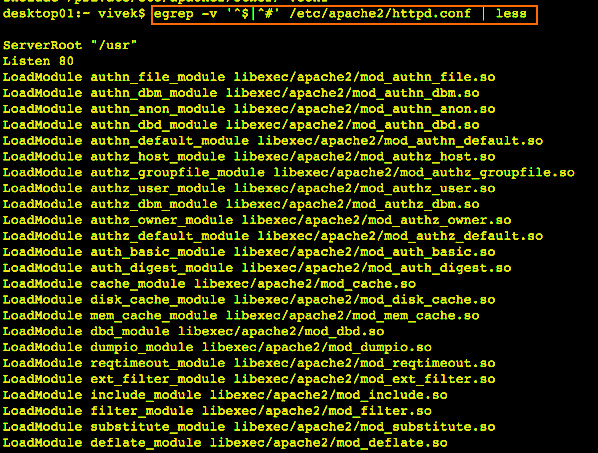grep 命令系列:如何只查看配置文件中未被注释的有效配置行
=========================================================
大多数的Linux和类Unix系统的配置文件中都有许多的注释行,但是有时候我只想看其中的有效配置行。那我怎么才能只看到quid.conf或httpd.conf这样的配置文件中的非注释命令行呢?怎么去掉这些注释或者空行呢?
我们可以使用 UNIX/BSD/OS X/Linux 这些操作系统自身提供的 grep,sed,awk,perl或者其他文本处理工具来查看配置文件中的有效配置命令行。
### grep 命令示例——去掉注释 ###
可以按照如下示例使用grep命令:
$ grep -v "^#" /path/to/config/file
$ grep -v "^#" /etc/apache2/apache2.conf
示例输出:
ServerRoot "/etc/apache2"
LockFile /var/lock/apache2/accept.lock
PidFile ${APACHE_PID_FILE}
Timeout 300
KeepAlive On
MaxKeepAliveRequests 100
KeepAliveTimeout 15
<IfModule mpm_prefork_module>
StartServers 5
MinSpareServers 5
MaxSpareServers 10
MaxClients 150
MaxRequestsPerChild 0
</IfModule>
<IfModule mpm_worker_module>
StartServers 2
MinSpareThreads 25
MaxSpareThreads 75
ThreadLimit 64
ThreadsPerChild 25
MaxClients 150
MaxRequestsPerChild 0
</IfModule>
<IfModule mpm_event_module>
StartServers 2
MaxClients 150
MinSpareThreads 25
MaxSpareThreads 75
ThreadLimit 64
ThreadsPerChild 25
MaxRequestsPerChild 0
</IfModule>
User ${APACHE_RUN_USER}
Group ${APACHE_RUN_GROUP}
AccessFileName .htaccess
<Files ~ "^\.ht">
Order allow,deny
Deny from all
Satisfy all
</Files>
DefaultType text/plain
HostnameLookups Off
ErrorLog /var/log/apache2/error.log
LogLevel warn
Include /etc/apache2/mods-enabled/*.load
Include /etc/apache2/mods-enabled/*.conf
Include /etc/apache2/httpd.conf
Include /etc/apache2/ports.conf
LogFormat "%v:%p %h %l %u %t \"%r\" %>s %O \"%{Referer}i\" \"%{User-Agent}i\"" vhost_combined
LogFormat "%h %l %u %t \"%r\" %>s %O \"%{Referer}i\" \"%{User-Agent}i\"" combined
LogFormat "%h %l %u %t \"%r\" %>s %O" common
LogFormat "%{Referer}i -> %U" referer
LogFormat "%{User-agent}i" agent
CustomLog /var/log/apache2/other_vhosts_access.log vhost_combined
Include /etc/apache2/conf.d/
Include /etc/apache2/sites-enabled/
想要跳过其中的空行,可以使用 [egrep 命令][1], 示例:
egrep -v "^#|^$" /etc/apache2/apache2.conf
## or pass it to the page such as more or less ##
egrep -v "^#|^$" /etc/apache2/apache2.conf | less
## Bash function ######################################
## or create function or alias and use it as follows ##
## viewconfig /etc/squid/squid.conf ##
#######################################################
viewconfig(){
local f="$1"
[ -f "$1" ] && command egrep -v "^#|^$" "$f" || echo "Error $1 file not found."
}
示例输出:

*图 01: Unix/Linux Egrep 除去注释行和空行*
### 理解 grep/egrep 命令行选项 ###
-v 选项,选择出不匹配的命令行。该选项适用于所有基于posix的系统。正则表达式 `^$` 匹配出所有的非空行, `^#` 匹配出所有的不以“#”开头的非注释行。
### sed 命令示例 ###
可以按照如下示例使用 GNU 上的 sed 命令:
$ sed '/ *#/d; /^ *$/d' /path/to/file
$ sed '/ *#/d; /^ *$/d' /etc/apache2/apache2.conf
GNU 或 BSD 上的 sed 也可以修改配置文件。下面的命令的作用是原地编辑文件,并以特定(比如 .bak)备份文件:
sed -i'.bak.2015.12.27' '/ *#/d; /^ *$/d' /etc/apache2/apache2.conf
更多信息见参考手册 - [grep(1)][2], [sed(1)][3]。
--------------------------------------------------------------------------------
via: http://www.cyberciti.biz/faq/shell-display-uncommented-lines-only/
作者:Vivek Gite
译者:[sonofelice](https://github.com/sonofelice)
校对:[wxy](https://github.com/wxy)
本文由 [LCTT](https://github.com/LCTT/TranslateProject) 原创编译,[Linux中国](https://linux.cn/) 荣誉推出
[1]:http://www.cyberciti.biz/faq/grep-regular-expressions/
[2]:http://www.manpager.com/linux/man1/grep.1.html
[3]:http://www.manpager.com/linux/man1/sed.1.html